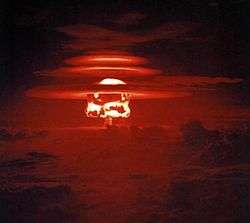Castle Yankee
| Castle Yankee | |
|---|---|
 | |
| Information | |
| Country | United States |
| Test series | Operation Castle |
| Test site | Bikini Atoll |
| Date | May 5, 1954 |
| Test type | Atmospheric |
| Yield | 13.5 Mt |

Castle Yankee was the code name given to one of the tests in the Operation Castle series of American tests of thermonuclear bombs. It was originally intended as a test of a TX-16/EC-16 bomb, but the design became obsolete after the Castle Bravo test was successful. The test device was replaced with a TX-24/EC-24 bomb which was detonated on May 5, 1954, at Bikini Atoll. It released energy equivalent to 13.5 megatons of TNT, the second-largest yield ever in a U.S. fusion weapon test.
Jughead
Yankee was originally intended to be a test of a TX-16/EC-16, a weaponized version of the large and complex Ivy Mike device. A small number of emergency capability EC-16s were produced, without being tested, to provide a stop-gap thermonuclear weapon capability in response to the Russian nuclear weapons program.
The test device, code-named "Jughead", had been prepared as a backup in case the non-cryogenic Castle Bravo "Shrimp" device failed to work. The test of Jughead was cancelled when the Bravo test was successful, and the cryogenic EC-16s were withdrawn and dismantled.
Runt II
Jughead was replaced by the "Runt II" device (a TX-24/EC-24), developed from the Castle Romeo "Runt" device (a TX-17/EC-17). Externally identical, the principal difference between them was in the fuel for the fusion stage. While Runt used natural lithium (with 7.5% of the Lithium-6 isotope), Runt II used the same partially enriched lithium (approximately 40% Lithium-6) as the Shrimp device.
It was detonated on May 5, 1954, at Bikini Atoll of the Marshall Islands, on a barge moored in the middle of the crater from the Castle Union test.
Although it had been predicted to produce a yield of 6 to 10 megatons, it actually produced a yield of 13.5 megatons, the second-largest ever yield in a U.S. fusion weapon test. Like the Mike, Bravo and Romeo tests, a large percentage of the yield was produced by fast fission of the natural uranium tamper. Of the total yield, 7 megatons were from fission; the other 6.5 megatons were from fusion reactions. The high fusion yield was due to the enriched fuel and set a U.S. record that stood until Hardtack Poplar in 1958.
External links
- The short film Operation Castle Commanders Report (1954) is available for free download at the Internet Archive
- The short film Military Effects Studies Operation Castle (1954) is available for free download at the Internet Archive
- The short film Nuclear Test Film - Operation Castle (1954) is available for free download at the Internet Archive
- Operation Castle
References
- Chuck Hansen, U. S. Nuclear Weapons: The Secret History (Arlington: AeroFax, 1988)